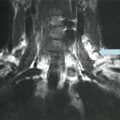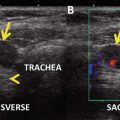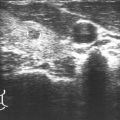© Springer International Publishing Switzerland 2016
David S. Cooper and Cosimo Durante (eds.)Thyroid Cancer10.1007/978-3-319-22401-5_2323. A Case of Papillary Thyroid Cancer Without Aggressive Histological Features with Nodal Metastases in an Older Patient
(1)
Department of Medical, Surgical and Neurological Sciences, University of Siena, Siena, Italy
(2)
Policlinico Santa Maria alle Scotte, Viale Bracci 1, Viale Bracci 1, 53100 Siena, Italy
Keywords
Thyroid cancerThyroglobulinLymph node metastasesRadioiodineThe Case
A 58-year-old woman was found to have a 2 cm right thyroid nodule on routine physical examination. Thyroid ultrasound confirmed a 2.4 cm nodule that was hypoechoic with microcalcifications and internal vascularity. The contralateral lobe showed a hypoechoic 0.8 cm nodule. Fine-needle aspiration (FNA) performed on the right nodule showed a “malignant nodule” (Bethesda class V). No lymph nodes were found in the central and lateral compartments at presurgical neck ultrasound. She underwent a total thyroidectomy and central lymph node dissection. The histological diagnosis was intrathyroidal papillary thyroid carcinoma (2.2 cm in the right lobe) and microscopic nodal metastases in the central neck (4 nodes, <0.2 cm) T2N1aMX, stage III according to the AJCC/UICC system, intermediate risk according to the American Thyroid Association (ATA) risk stratification.
Her surgeon recommended postsurgical radioiodine remnant ablation. The patient came to us to discuss whether this was necessary.
Assessment and Literature Review
For the past 40 years, many clinicians have recommended radioiodine remnant ablation for all differentiated thyroid cancer patients with a primary tumor size greater than 1–1.5 cm. Using this approach, the percentage of patients with differentiated thyroid cancer (DTC) receiving radioiodine remnant ablation as part of the first course of therapy has increased from 6.1 to 48.7 % between 1973 and 2006 [1]. However, the last several years have seen an interest in an individualized risk-adapted management approach to DTC, whereby the intensity of therapy and monitoring is tailored to the expected aggressiveness of the malignancy for each patient [2, 3].
The 2015 American Thyroid Association guidelines [4] state that radioactive iodine (RAI) remnant ablation is not routinely recommended after thyroidectomy for ATA low-risk DTC patients, whereas RAI therapy is routinely recommended after total thyroidectomy for ATA high-risk differentiated thyroid cancer patients. Whether RAI ablation is necessary in patients with ATA intermediate risk is still controversial, and the ATA guidelines state that in this category RAI may be considered on an individual basis.
It is well known that the risk of recurrent disease in N1 patients is related to the number and size of involved lymph nodes [5]. The median risk of nodal recurrence varies significantly by clinical staging, from 2 % in clinical N0 patients to 22 % in clinical N1-positive patients. There is a graded risk of structural disease recurrence, varying from 4 % in patients with fewer than five metastatic lymph nodes to 5 % if all involved lymph nodes are <0.2 cm, to 19 % if more than five lymph nodes are involved, to 21 % if more than ten lymph nodes are involved, to 22 % if macroscopic lymph node metastases are clinically evident (clinical N1 disease), and to as high as 27–32 % if any metastatic lymph node is greater than 3 cm [5]. More recently, the impact of nodal status on outcome has been retrospectively evaluated in 834 patients 45 years or older [6]. A significantly poorer disease-specific survival (DSS) and local or distant recurrence-free survival (RFS) were observed in older patients with pN1b disease at diagnosis (DSS 91 %, regional RFS 90 %, and distant RFS 84 %, respectively) when compared to patients with pN0/NX and pN1a disease (DSS was 100 % for pN0/X and pN1a disease; regional RFR was 99 % for pN0/X and 93 % for pN1a disease; distant RFR was 99 % for pN0/X and pN1a disease). No difference in the clinical outcome was observed between N0/NX and N1a disease [6].
Data about the benefit of RAI ablation in patients with lymph node metastases at diagnosis are not conclusive. There is some evidence that there may be a benefit of adjuvant RAI treatment in improving overall and disease-specific survival as well as disease-free survival in patients with nodal metastases aged ≥45 years [7]. Furthermore, the greatest treatment benefits are observed in patients with N1b disease or lymph nodes >1 cm in diameter [8]. The adjuvant therapeutic efficacy of RAI treatment in improving outcome in patients > age 45 with isolated microscopic central neck disease, in the absence of other adverse features, is unknown. Thus, the relatively good overall prognosis of this group and the uncertainty of RAI therapeutic efficacy for this subgroup are important considerations in decision-making.
Several studies have shown that postoperative/pre-RAI ablation nonstimulated or stimulated Tg can predict disease-free remission and mortality in DTC patients [9–14]. Based on this observation, several authors have suggested that postoperative/pre-ablative Tg, performed approximately 3–6 months after total thyroidectomy, can be used for planning RAI ablation therapy in low-/intermediate-risk DTC patients [14–16]. Specifically, in intermediate DTC patients, an unstimulated postoperative Tg <1.0 ng/ml was associated with excellent clinical outcome and recurrence rate <1 % [16] in patients that did not receive RAI ablation. The negative predictive value of stimulated serum Tg <2.0 pg/ml was 94.1 % for intermediate-risk patients, and it increased to 97 % when stimulated serum Tg values were combined with negative neck ultrasound [17]. A similar significant decrease of recurrences is reported in intermediate-risk patients with negative postsurgical neck ultrasonography [18].
Stay updated, free articles. Join our Telegram channel

Full access? Get Clinical Tree






